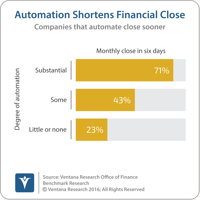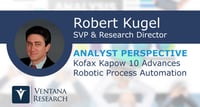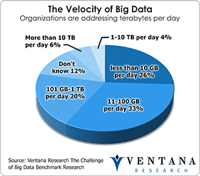Robotic process automation (RPA) relies on programming or the application of analytical algorithms to execute the most appropriate action in an automated workflow. RPA enables business users to configure a “robot” (actually, computer software) to interact with applications or data sources to process a transaction, move or manipulate data, communicate with other digital systems and manage machine-to-machine and man-to-machine interactions. This technology is gaining increasing notice by finance...
Read More
Topics:
Operations,
automation,
close,
closing,
Continuous Accounting,
finance,
banking,
Robotic Process Automation,
Accounting,
web crawler,
legacy systems,
bank
Kofax offers Kapow, robotic process automation (RPA) software used to acquire information from a range of sources without human intervention and without having to write code. These sources include websites, applications, unstructured documents, data stores and desktop spreadsheets. RPA software does repetitive, low-value work that otherwise may be performed by person. It saves time in these tasks, completing them sooner and freeing skilled individuals to concentrate on work that utilizes their...
Read More
Topics:
Office of Finance,
Operations,
close,
finance,
banking,
Digital Technology
At this year’s Global Pricing Forum, host Nomis Solutions announced the availability of its Discretion Manager software, which supports dynamic price negotiations. The annual event brings together thought leaders and practitioners interested in pricing. Nomis currently has 17 of the largest 100 banks as customers. With more customers, this year’s event had larger attendance than last year’s.
Read More
Topics:
Big Data,
Sales,
Office of Finance,
Operational Performance Management (OPM),
credit,
financial analytics,
Nomis Solutions,
PRO,
Analytics,
Business Analytics,
Business Performance Management (BPM),
Financial Performance Management (FPM),
Sales Performance Management (SPM),
banking,
Financial Services
I recently attended the 2012 Global Pricing Forum hosted by Nomis Solutions, a provider of software and services to banking and finance companies. This annual event brings together thought leaders and practitioners in the area of pricing and revenue optimization (PRO). This technique uses analytics to sift through large data sets to tease out customer behavior characteristics, identify customer segments and quantify their price sensitivities. These complex calculations require software designed...
Read More
Topics:
Sales,
Office of Finance,
Operational Performance Management (OPM),
credit,
financial analytics,
Nomis Solutions,
PRO,
Analytics,
Business Analytics,
Financial Performance Management (FPM),
Sales Performance Management (SPM),
Supply Chain Performance Management (SCPM),
banking,
Financial Services













